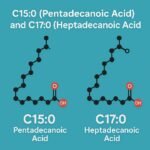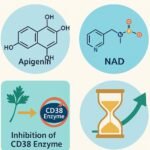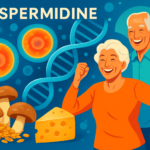Introduction
Ageing is a complex biological process characterised by progressive functional decline at cellular and organismal levels. Among the various hallmarks of ageing, deregulated nutrient sensing stands out as a critical factor influencing longevity and health span. This disruption in the body’s ability to properly detect and respond to nutrient levels has far-reaching implications for cellular function, metabolism, and age-related diseases. Understanding the intricate relationship between nutrient sensing and ageing is crucial for developing interventions that promote healthy ageing and extend lifespan.
Understanding Nutrient Sensing
Nutrient sensing pathways are sophisticated cellular mechanisms that detect and respond to available nutrients, ultimately controlling metabolism and energy allocation. Several key pathways play crucial roles:
- The Insulin/IGF-1 Signalling (IIS) Pathway
The insulin/IGF-1 signalling pathway plays a crucial role in nutrient sensing. In younger organisms, this pathway promotes growth and metabolism in response to nutrient availability. However, with ageing, there is often a dysregulation of this pathway, leading to insulin resistance and metabolic disorders. This change can contribute to the development of age-related diseases such as type 2 diabetes and cardiovascular diseases
- Responds primarily to glucose and amino acids
- Regulates glucose metabolism and protein synthesis
- Influences cell growth, proliferation, and survival
- First pathway discovered to influence aging in model organisms
- mTOR (mechanistic Target of Rapamycin)
The mechanistic target of rapamycin (mTOR) is another key player in nutrient sensing. mTOR integrates signals from nutrients, growth factors, and cellular energy status to regulate cell growth and metabolism. Dysregulation of mTOR signalling has been linked to accelerated ageing and age-related pathologies. Inhibition of mTOR has shown potential in extending lifespan in various model organisms by mimicking the effects of caloric restriction
- Integrates signals from amino acids, growth factors, and energy status
- Controls protein synthesis and autophagy
- Acts as a master regulator of cell growth and metabolism
- Highly conserved across species
- AMPK (AMP-activated Protein Kinase)
AMP-activated protein kinase (AMPK) acts as an energy sensor within cells. It is activated under low energy conditions and promotes catabolic processes that generate ATP while inhibiting anabolic processes that consume ATP. Ageing is associated with decreased AMPK activity, which can lead to impaired metabolic homeostasis and increased susceptibility to age-related diseases.
- Senses cellular energy status through AMP:ATP ratio
- Activates catabolic pathways while inhibiting anabolic processes
- Promotes stress resistance and energy conservation
- Becomes less sensitive with age
- Sirtuins
Sirtuins are a family of proteins that play critical roles in regulating cellular processes related to ageing, metabolism, and stress response. They are NAD+-dependent deacetylases, which means they require nicotinamide adenine dinucleotide (NAD+) to function and are involved in the removal of acetyl groups from lysine residues on proteins. This activity influences various cellular functions, including gene expression, DNA repair, and metabolic regulation.
- NAD+-dependent protein deacetylases
- Respond to cellular energy status and stress
- Regulate numerous metabolic processes and stress responses
- Play crucial roles in healthy ageing
Because conditions and availability of nutrients vary greatly at any given time, we have evolved above 4 nutrient sensing pathways. These pathways ensure that our body takes in the correct amount of nutrition and fine tunes that delicate balance as conditions change. The pathways work together to achieve a state of metabolic balance known as homeostasis.
How Does Our Metabolism Become Deregulated?
Our metabolism naturally produces harmful byproducts, even when functioning optimally. When these byproducts exceed our body’s ability to manage them, they disrupt our metabolic pathways in three main ways:
- Endoplasmic Reticulum (ER) Stress
- Occurs when the ER struggles to properly fold proteins
- The ER is crucial for protein folding and transport
- When stressed, it allows misfolded proteins to accumulate
- These misfolded proteins are linked to age-related conditions like Alzheimer’s
- Oxidative Stress
- Results from an imbalance between reactive oxygen species and antioxidants
- While reactive oxygen species normally help with cell signaling, excess amounts are harmful
- Common triggers include:
- UV radiation
- Chemicals (drugs, pesticides, industrial chemicals)
- Personal care products (cosmetics, fragrances)
- Environmental factors (pollution, tobacco smoke)
- Food additives
- Mitochondrial Dysfunction
- Mitochondria convert food into energy
- As we age, mitochondrial DNA becomes damaged
- This damage causes them to produce more harmful reactive oxygen species
- Creates a cycle of increased inflammation and further DNA damage
The Link Between Nutrient Sensing and Aging
The connection between nutrient sensing and ageing is fundamentally rooted in evolutionary biology. These pathways evolved to help organisms survive periods of nutrient scarcity and abundance. However, in modern conditions of constant nutrient availability, their dysregulation can accelerate ageing through several mechanisms:
Molecular Mechanisms
- Chronic activation of nutrient-sensing pathways
- Reduced sensitivity to nutrients
- Impaired cellular repair and maintenance
- Disrupted metabolic homeostasis
Cellular Impact
- Increased cellular stress
- Reduced autophagy
- Mitochondrial dysfunction
- Compromised protein quality control
Impact of Deregulated Nutrient Sensing on Longevity
Research has demonstrated clear connections between nutrient sensing pathway dysregulation and reduced lifespan:
- Evidence from Model Organisms
- Mutations reducing insulin/IGF-1 signalling extend lifespan in worms, flies, and mice
- mTOR inhibition increases longevity across species
- AMPK activation promotes longevity
- Sirtuin activation extends lifespan in multiple organisms
- Human Studies
- Centenarians often display genetic variants affecting nutrient sensing pathways
- Reduced insulin/IGF-1 signalling correlates with longevity
- Metabolic disorders linked to accelerated ageing
Cellular Consequences of Deregulated Nutrient Sensing
The cellular impact of dysregulated nutrient sensing manifests in multiple ways:
- Metabolic Effects
- Impaired glucose homeostasis
- Altered lipid metabolism
- Disrupted protein synthesis and turnover
- Mitochondrial dysfunction
- Stress Response Impact
- Reduced ability to respond to cellular stress
- Compromised protein quality control
- Impaired DNA repair mechanisms
- Decreased cellular resilience
Deregulated Nutrient Sensing in Age-Related Diseases
The dysregulation of nutrient sensing pathways contributes significantly to various age-related diseases:
- Type 2 Diabetes
- Insulin resistance and impaired glucose homeostasis
- Chronic mTOR activation leading to metabolic dysfunction
- Reduced AMPK activity affecting energy metabolism
- Connection to obesity and metabolic syndrome
- Cardiovascular Diseases
- Altered metabolism in cardiac tissue
- Vascular ageing through disrupted nutrient sensing
- Impact on cellular energy management
- Inflammation and oxidative stress
- Neurodegenerative Diseases
- Impaired protein quality control
- Disrupted brain energy metabolism
- Altered autophagy affecting neuronal health
- Links to Alzheimer’s and Parkinson’s diseases
Potential Therapeutic Interventions
Several promising approaches target nutrient sensing pathways to promote healthy aging:
- Dietary Interventions
- Caloric Restriction
- Reduces mTOR activation
- Increases AMPK activity
- Promotes sirtuin activation
- Well-documented life-extending effects
- Intermittent Fasting
- Modulates nutrient sensing pathways
- Improves metabolic flexibility
- Enhances stress resistance
- Shows promise in longevity studies
Pharmacological Approaches
- Rapamycin and Rapalogs
- Direct mTOR inhibitors
- Shown to extend lifespan in multiple species
- Currently in clinical trials for aging-related conditions
- Metformin
- Activates AMPK
- Improves insulin sensitivity
- Being studied for anti-aging properties
- Well-established safety profile
- Sirtuin Activators
- Compounds like resveratrol
- NAD+ precursors
- Target multiple ageing pathways
Future Research Directions
The field continues to evolve with several promising areas for investigation:
- Research Priorities
- Development of more specific pathway modulators
- Understanding tissue-specific effects
- Identifying optimal intervention timing
- Developing personalised approaches
- Emerging Technologies
- Advanced metabolomics for pathway analysis
- Novel drug delivery systems
- Biomarker development for monitoring interventions
- Integration of artificial intelligence in drug discovery.
Clinical Translation
- Large-scale human trials of promising compounds
- Development of combination therapies
- Investigation of age-related disease prevention
- Implementation of precision medicine approaches
Conclusion
Deregulated nutrient sensing represents a fundamental hallmark of ageing that interlinks with multiple biological processes. Understanding and targeting these pathways offers promising opportunities for promoting healthy ageing and treating age-related diseases. Key takeaways include:
- The central role of nutrient sensing in ageing biology
- Multiple interconnected pathways affecting cellular health
- Promising therapeutic approaches in development
- Need for continued research and clinical translation
The future of ageing research and intervention lies in developing targeted approaches to modulate these pathways effectively while minimising side effects. As our understanding grows, so does the potential for meaningful interventions in the ageing process.








